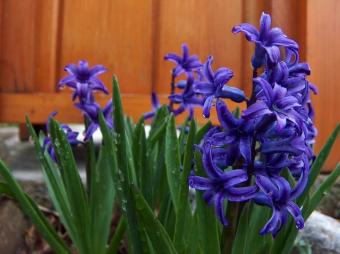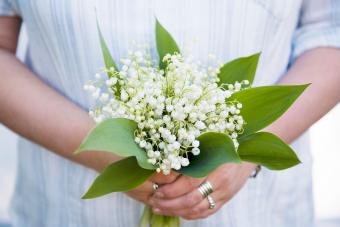
Planting flowers by zone is a way to ensure you have a healthy and productive flower garden this year. In agricultural terms, "zones" are unique geographical locales where specific climates dictate what plants will best grow there. The United States Department of Agriculture (USDA) refers to them as "hardiness zones," and they are an essential tool for agriculture, as they provide a blueprint for an area's most appropriate plants. The act of planting flowers by zone centers around learning about your zone, finding plants that are best suited to that zone, and focusing your efforts on those plants.
How to Find Your Zone
The USDA Plant Hardiness Zone map is one of the most widely referenced zone maps in the country. Not only is the map comprehensive, but it is also highly interactive and is searchable. You can input your zip code and quickly find a detailed map of your area and the zone you are in. You should take some time to see which zone you reside in before planning your flower garden. If you are outside of the United States, then you can find information on European hardiness zones at GardenWeb.com.
USDA Zones Defined
There are 13 zones as defined by the USDA Hardiness Zone map. However, not all of these zones are adequate for cultivation of non-native flower species. Some of the zones are far too cold or far too hot to provide adequate resources for anything but a very specialized set of plants. Zones one and two are most commonly found in Alaska, where anything but native wild flowers will have a hard time taking root through the long winters. Zones twelve and thirteen aren't even found on the continental United States; they are only on the island of Puerto Rico. By far, the most commonly encountered zones are zones three through ten.
Below, you will see a basic outline of the soils found in various hardiness zones. If you would like to learn more about the specific soil in your area, you should consult the USDA Web Soil Survey site. This site will provide you with information on the specific soils that exist in your area.
Zone Three and Four
In the United States, zones three and four sit in the large area of land between the Rocky Mountains and the Great Lakes north of Nebraska.
Weather
These zones are known for cold winters and short summers. The best flowering plants for these zones are generally shrubs like the Van Houtte spirea and certain hydrangeas. However, some tougher flowers like the Rugosa rose are able to handle the weather here. In the summer, extensive watering is required to supplement the lack of rains.
Soil of Zones Three and Four
Soil types in zones three and four can vary significantly. Near the Great Lakes, the clay can be present below the topsoil. Throughout most of the zone area, soil is primarily Alfisol. This is a term that indicates a loam soil that has developed under a heavy forest canopy and is rich in organic matter if the soil has not been recently disturbed.
Flowers to Plant in Zones Three and Four

blue hyacinth
This image is part of the morguefile archive and the morguefile license
Source: http://morguefile.com/archive/?display=133
- Lily-of-the-Valley: This flower is comprised of small, white clusters of dainty and highly aromatic flowers. It does well in partial to full shade and should be watered deeply once every few days until established. Afterward, it can be watered less depending on how much rain you are getting.
- Scarlet Phlox: This flower requires little to no attention and is known to establish well on its own. It produces a bed (or carpet) of pink and purple flowers atop a bed of evergreen leaves. You have to do little to no watering with an established phlox plant.
- Carnations: Carnations are a heavy-bodied flower and are highly popular in floral arrangements. They flower from mid spring to late summer and require a regular watering schedule.
- Hyacinths: These flowers are very hardy perennials that require very little work. They produce large, poofy heads of flowers that vary widely in color. They should be planted in full sun, and will come back every year.
- Black-Eyed Susan: These plants produce a multitude of yellow flowers that will continuously bloom until the first frost. They require very little if any watering once they are established. This is because they are primarily a field plant and are adapted to very harsh conditions.
Zone Five and Six
These zones have very cold, windy winters and long, dry summers. Specifically, the states that have the largest amount of land solely in zones five or six are Iowa, Kansas, Nebraska, Missouri, Illinois, and Ohio. Tornado alley goes through zone six, and this plays a huge impact on the types of plants that are able to do well here.
Weather
The commonly dry summers in these areas mean that drought tolerant flowers like marigolds, and roses like the multiflora rose, will do best here. Look for plants with a semi-waxy cuticle, as these will be the ones that are best capable of holding in moisture. Drought tolerant flowers are recommended here and any non-drought tolerant plants should be watered very deeply throughout the summer.
Soil of Zones Five and Six
Soil in zones five and six is comprised primarily of silty loam. This soil provides a good mixture of moisture retention and drainage.
Flowers to Plant in Zones Five and Six

Blue Hydrangea Flowers Source: http://www.morguefile.com/archive/display/222020 Permission: Morguefile image subject to morguefile license
- Giant Allium: Alliums get a lot of attention due to their unique shape and flower pattern. They are essentially a ball of flowers on top of a long, green stem. They are considered a "novelty bulb" and will re-flower every year because they are a perennial. You should be careful to not over-water any bulb plant because you can oversaturate the soil and cause the bulb to rot.
- Pink Coneflower: These flowers resemble pink daisies, and will stay in flower for a long time. They are considered "drought resistant" flowers, so they rarely need to be watered.
- Wonder of Staffa Asters: These are very delicate looking flowers that are actually fairly hardy. The delicate, blue flowers will continue to bloom from mid-summer to late frost and require little watering.
- All Summer Beauty Hydrangeas: These produce copious amounts of large flower heads. The plant will bloom from mid-summer through the first frost and requires very little watering. In acidic soils, the flowers will turn blue. In alkaline soils, the flowers will turn pink.
- Red Carpet Lily: Thick, red flower petals and deep green leaves characterize the appearance of this flower. The flower will bloom for weeks starting in early summer and requires full sun with a regular watering schedule. Try watering lightly once every couple of nights and spritzing the petals in between.
Zone Seven and Eight
Most of Texas falls into one of these two zones, as does most of California and half of Oregon.
Weather
These zones are known for their relatively mild winters and warm, dry summers. Zones seven and eight present a unique situation for gardeners because the dry, hot winters are countered by winters where many trees may not ever lose a single leaf. This means that the flower growing season is often extended to a "year-round" status. For example, in western Oregon they endure significant rains throughout the winter and rarely ever dip into freezing temperatures. Marigolds, carnations, roses, and nearly any flower you can imagine has the potential to do well in these zones without many special considerations.
Soil of Zones Seven and Eight
Zones seven and eight get a lot of rainfall every year and have poorly-drained soils. The soils here are comprised of heavy amounts of clay, which can significantly limit your options with bulbs and other plants. Many gardeners in zones seven and eight use raised beds for their flowers to exert more control over the soil type they are planting in.
Flowers to Plant in Zones Seven and Eight

A pink hibiscus bloom. Used under license from iStock.com.
- Hibiscus: Hibiscus flowers are considered winter hardy flowers that can often be seen lasting all winter in zone eight. They are a very popular field-grown plant, which means that they are a very hardy plant that requires very little attention. These bell-shaped flowers do best when planted in full sun.
- Freckled Geisha Japanese Iris: Freckled geisha is a very showy, very delicate plant that can survive in a broad range of conditions when tended to properly. They require full sun or partial shade and need to be watered regularly.
- Crater Lake Clematis: This is a very hardy flowering vine that produces numerous blue flowers. The flowers are large and are often used as a privacy barrier on fences. The vines grow vigorously without much help, requiring very little watering.
- Climbing Tea Rose: This climbing rose produces large numbers of roses throughout the growing season. Unlike many other roses, this rose requires very little tending and is considered to be one of the hardiest of the roses. These are optimized for zone seven, but can be used in zone eight as well.
- Major Wheeler Honeysuckle: This is a popular plant for hummingbirds. This plant grows very quickly and produces many red and gold flowers. It requires full sun or partial shade and a regular watering schedule should be used. Since the plant vines, consider spraying the leaves gently at night to allow them to keep their vigor. This will also help the flowers produce nectar that famously attracts hummingbirds.
Zone Nine and Ten
Zones nine and ten reside almost exclusively in California, Florida, and Hawaii.
Weather
These zones are known for relatively stable temperatures throughout the year. Gardeners here can also expect high humidity and rain in the winter months. Due to this, it is important to get flowers that are not prone to fungus issues. Fuchsias and poinsettias are especially well adapted to these zones.
Soil of Zones Nine and Ten
Zones nine and ten are very arid regions. These areas are known for having well-drained, sandy soils that are not prone to moisture retention. A predominant soil here is called San Joaquin, which is loam on top of a deep clay sublayer. This means that you need to plant flowers that can survive these well-drained and moisture-barren conditions.

Flowers to Plant in Zones Nine and Ten
- Fanfare Gaillardia: This unique, wheel-shaped flower will bloom from June through September. It grows very well in dry conditions, making it suitable for zones nine and ten.
- Summer Breeze Agastache: This is a popular flower for use in rock gardens throughout zones nine and ten. The small, succulent flowers are very hardy to dry conditions and come in a broad range of colors. Be careful not to overwater these plants, as the succulent leaves can start to rot.
- Casablanca Lily: These lilies are actually from Peru and not Morocco as the name suggests. This flower is very drought tolerant and requires only minimal watering. The well-drained soils of zones nine and ten are very good for this plant.
Learn About Your Zone
To get a more thorough understanding of what specific plants will do well in your zone, check out the NGA Plant Finder tool at the National Gardening Association website. All you have to do is plug in what type of plants you're interested in and what zone you live in. Their database is quite extensive and the National Gardening Association is one of the most highly respected gardening organizations in the country. By using tools like this and learning about your zone, you are much more likely to have a successful garden.







